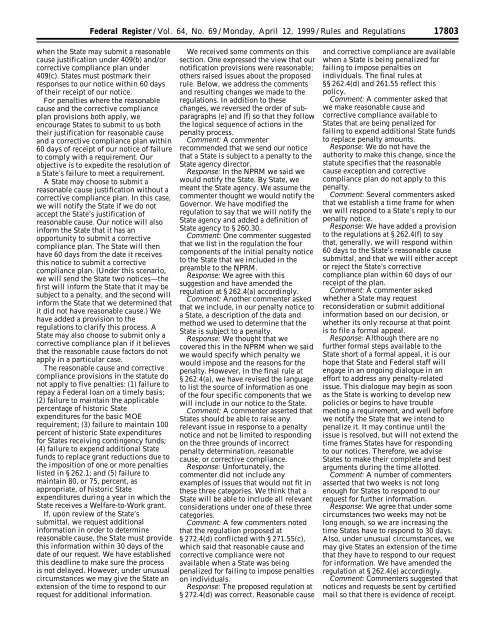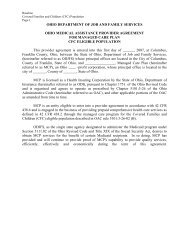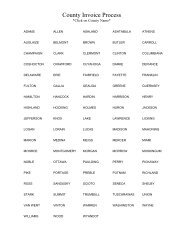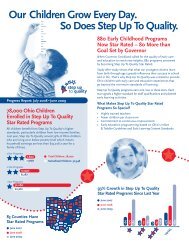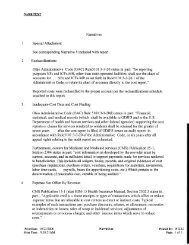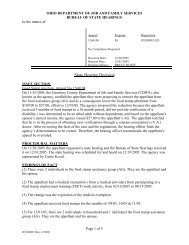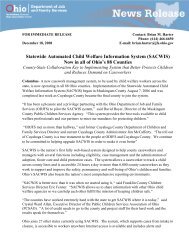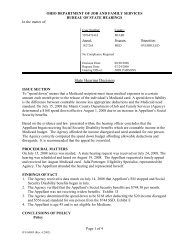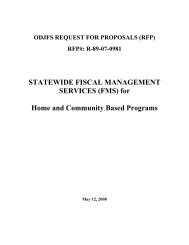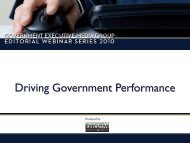Final TANF Rule as published in the Federal Register 4/12/1999
Final TANF Rule as published in the Federal Register 4/12/1999
Final TANF Rule as published in the Federal Register 4/12/1999
You also want an ePaper? Increase the reach of your titles
YUMPU automatically turns print PDFs into web optimized ePapers that Google loves.
<strong>Federal</strong> <strong>Register</strong> / Vol. 64, No. 69 / Monday, April <strong>12</strong>, <strong>1999</strong> / <strong>Rule</strong>s and Regulations<br />
when <strong>the</strong> State may submit a re<strong>as</strong>onable<br />
cause justification under 409(b) and/or<br />
corrective compliance plan under<br />
409(c). States must postmark <strong>the</strong>ir<br />
responses to our notice with<strong>in</strong> 60 days<br />
of <strong>the</strong>ir receipt of our notice.<br />
For penalties where <strong>the</strong> re<strong>as</strong>onable<br />
cause and <strong>the</strong> corrective compliance<br />
plan provisions both apply, we<br />
encourage States to submit to us both<br />
<strong>the</strong>ir justification for re<strong>as</strong>onable cause<br />
and a corrective compliance plan with<strong>in</strong><br />
60 days of receipt of our notice of failure<br />
to comply with a requirement. Our<br />
objective is to expedite <strong>the</strong> resolution of<br />
a State’s failure to meet a requirement.<br />
A State may choose to submit a<br />
re<strong>as</strong>onable cause justification without a<br />
corrective compliance plan. In this c<strong>as</strong>e,<br />
we will notify <strong>the</strong> State if we do not<br />
accept <strong>the</strong> State’s justification of<br />
re<strong>as</strong>onable cause. Our notice will also<br />
<strong>in</strong>form <strong>the</strong> State that it h<strong>as</strong> an<br />
opportunity to submit a corrective<br />
compliance plan. The State will <strong>the</strong>n<br />
have 60 days from <strong>the</strong> date it receives<br />
this notice to submit a corrective<br />
compliance plan. (Under this scenario,<br />
we will send <strong>the</strong> State two notices—<strong>the</strong><br />
first will <strong>in</strong>form <strong>the</strong> State that it may be<br />
subject to a penalty, and <strong>the</strong> second will<br />
<strong>in</strong>form <strong>the</strong> State that we determ<strong>in</strong>ed that<br />
it did not have re<strong>as</strong>onable cause.) We<br />
have added a provision to <strong>the</strong><br />
regulations to clarify this process. A<br />
State may also choose to submit only a<br />
corrective compliance plan if it believes<br />
that <strong>the</strong> re<strong>as</strong>onable cause factors do not<br />
apply <strong>in</strong> a particular c<strong>as</strong>e.<br />
The re<strong>as</strong>onable cause and corrective<br />
compliance provisions <strong>in</strong> <strong>the</strong> statute do<br />
not apply to five penalties: (1) failure to<br />
repay a <strong>Federal</strong> loan on a timely b<strong>as</strong>is;<br />
(2) failure to ma<strong>in</strong>ta<strong>in</strong> <strong>the</strong> applicable<br />
percentage of historic State<br />
expenditures for <strong>the</strong> b<strong>as</strong>ic MOE<br />
requirement; (3) failure to ma<strong>in</strong>ta<strong>in</strong> 100<br />
percent of historic State expenditures<br />
for States receiv<strong>in</strong>g cont<strong>in</strong>gency funds;<br />
(4) failure to expend additional State<br />
funds to replace grant reductions due to<br />
<strong>the</strong> imposition of one or more penalties<br />
listed <strong>in</strong> § 262.1; and (5) failure to<br />
ma<strong>in</strong>ta<strong>in</strong> 80, or 75, percent, <strong>as</strong><br />
appropriate, of historic State<br />
expenditures dur<strong>in</strong>g a year <strong>in</strong> which <strong>the</strong><br />
State receives a Welfare-to-Work grant.<br />
If, upon review of <strong>the</strong> State’s<br />
submittal, we request additional<br />
<strong>in</strong>formation <strong>in</strong> order to determ<strong>in</strong>e<br />
re<strong>as</strong>onable cause, <strong>the</strong> State must provide<br />
this <strong>in</strong>formation with<strong>in</strong> 30 days of <strong>the</strong><br />
date of our request. We have established<br />
this deadl<strong>in</strong>e to make sure <strong>the</strong> process<br />
is not delayed. However, under unusual<br />
circumstances we may give <strong>the</strong> State an<br />
extension of <strong>the</strong> time to respond to our<br />
request for additional <strong>in</strong>formation.<br />
We received some comments on this<br />
section. One expressed <strong>the</strong> view that our<br />
notification provisions were re<strong>as</strong>onable;<br />
o<strong>the</strong>rs raised issues about <strong>the</strong> proposed<br />
rule. Below, we address <strong>the</strong> comments<br />
and result<strong>in</strong>g changes we made to <strong>the</strong><br />
regulations. In addition to <strong>the</strong>se<br />
changes, we reversed <strong>the</strong> order of subparagraphs<br />
(e) and (f) so that <strong>the</strong>y follow<br />
<strong>the</strong> logical sequence of actions <strong>in</strong> <strong>the</strong><br />
penalty process.<br />
Comment: A commenter<br />
recommended that we send our notice<br />
that a State is subject to a penalty to <strong>the</strong><br />
State agency director.<br />
Response: In <strong>the</strong> NPRM we said we<br />
would notify <strong>the</strong> State. By State, we<br />
meant <strong>the</strong> State agency. We <strong>as</strong>sume <strong>the</strong><br />
commenter thought we would notify <strong>the</strong><br />
Governor. We have modified <strong>the</strong><br />
regulation to say that we will notify <strong>the</strong><br />
State agency and added a def<strong>in</strong>ition of<br />
State agency to § 260.30.<br />
Comment: One commenter suggested<br />
that we list <strong>in</strong> <strong>the</strong> regulation <strong>the</strong> four<br />
components of <strong>the</strong> <strong>in</strong>itial penalty notice<br />
to <strong>the</strong> State that we <strong>in</strong>cluded <strong>in</strong> <strong>the</strong><br />
preamble to <strong>the</strong> NPRM.<br />
Response: We agree with this<br />
suggestion and have amended <strong>the</strong><br />
regulation at § 262.4(a) accord<strong>in</strong>gly.<br />
Comment: Ano<strong>the</strong>r commenter <strong>as</strong>ked<br />
that we <strong>in</strong>clude, <strong>in</strong> our penalty notice to<br />
a State, a description of <strong>the</strong> data and<br />
method we used to determ<strong>in</strong>e that <strong>the</strong><br />
State is subject to a penalty.<br />
Response: We thought that we<br />
covered this <strong>in</strong> <strong>the</strong> NPRM when we said<br />
we would specify which penalty we<br />
would impose and <strong>the</strong> re<strong>as</strong>ons for <strong>the</strong><br />
penalty. However, <strong>in</strong> <strong>the</strong> f<strong>in</strong>al rule at<br />
§ 262.4(a), we have revised <strong>the</strong> language<br />
to list <strong>the</strong> source of <strong>in</strong>formation <strong>as</strong> one<br />
of <strong>the</strong> four specific components that we<br />
will <strong>in</strong>clude <strong>in</strong> our notice to <strong>the</strong> State.<br />
Comment: A commenter <strong>as</strong>serted that<br />
States should be able to raise any<br />
relevant issue <strong>in</strong> response to a penalty<br />
notice and not be limited to respond<strong>in</strong>g<br />
on <strong>the</strong> three grounds of <strong>in</strong>correct<br />
penalty determ<strong>in</strong>ation, re<strong>as</strong>onable<br />
cause, or corrective compliance.<br />
Response: Unfortunately, <strong>the</strong><br />
commenter did not <strong>in</strong>clude any<br />
examples of issues that would not fit <strong>in</strong><br />
<strong>the</strong>se three categories. We th<strong>in</strong>k that a<br />
State will be able to <strong>in</strong>clude all relevant<br />
considerations under one of <strong>the</strong>se three<br />
categories.<br />
Comment: A few commenters noted<br />
that <strong>the</strong> regulation proposed at<br />
§ 272.4(d) conflicted with § 271.55(c),<br />
which said that re<strong>as</strong>onable cause and<br />
corrective compliance were not<br />
available when a State w<strong>as</strong> be<strong>in</strong>g<br />
penalized for fail<strong>in</strong>g to impose penalties<br />
on <strong>in</strong>dividuals.<br />
Response: The proposed regulation at<br />
§ 272.4(d) w<strong>as</strong> correct. Re<strong>as</strong>onable cause<br />
17803<br />
and corrective compliance are available<br />
when a State is be<strong>in</strong>g penalized for<br />
fail<strong>in</strong>g to impose penalties on<br />
<strong>in</strong>dividuals. The f<strong>in</strong>al rules at<br />
§§ 262.4(d) and 261.55 reflect this<br />
policy.<br />
Comment: A commenter <strong>as</strong>ked that<br />
we make re<strong>as</strong>onable cause and<br />
corrective compliance available to<br />
States that are be<strong>in</strong>g penalized for<br />
fail<strong>in</strong>g to expend additional State funds<br />
to replace penalty amounts.<br />
Response: We do not have <strong>the</strong><br />
authority to make this change, s<strong>in</strong>ce <strong>the</strong><br />
statute specifies that <strong>the</strong> re<strong>as</strong>onable<br />
cause exception and corrective<br />
compliance plan do not apply to this<br />
penalty.<br />
Comment: Several commenters <strong>as</strong>ked<br />
that we establish a time frame for when<br />
we will respond to a State’s reply to our<br />
penalty notice.<br />
Response: We have added a provision<br />
to <strong>the</strong> regulations at § 262.4(f) to say<br />
that, generally, we will respond with<strong>in</strong><br />
60 days to <strong>the</strong> State’s re<strong>as</strong>onable cause<br />
submittal, and that we will ei<strong>the</strong>r accept<br />
or reject <strong>the</strong> State’s corrective<br />
compliance plan with<strong>in</strong> 60 days of our<br />
receipt of <strong>the</strong> plan.<br />
Comment: A commenter <strong>as</strong>ked<br />
whe<strong>the</strong>r a State may request<br />
reconsideration or submit additional<br />
<strong>in</strong>formation b<strong>as</strong>ed on our decision, or<br />
whe<strong>the</strong>r its only recourse at that po<strong>in</strong>t<br />
is to file a formal appeal.<br />
Response: Although <strong>the</strong>re are no<br />
fur<strong>the</strong>r formal steps available to <strong>the</strong><br />
State short of a formal appeal, it is our<br />
hope that State and <strong>Federal</strong> staff will<br />
engage <strong>in</strong> an ongo<strong>in</strong>g dialogue <strong>in</strong> an<br />
effort to address any penalty-related<br />
issue. This dialogue may beg<strong>in</strong> <strong>as</strong> soon<br />
<strong>as</strong> <strong>the</strong> State is work<strong>in</strong>g to develop new<br />
policies or beg<strong>in</strong>s to have trouble<br />
meet<strong>in</strong>g a requirement, and well before<br />
we notify <strong>the</strong> State that we <strong>in</strong>tend to<br />
penalize it. It may cont<strong>in</strong>ue until <strong>the</strong><br />
issue is resolved, but will not extend <strong>the</strong><br />
time frames States have for respond<strong>in</strong>g<br />
to our notices. Therefore, we advise<br />
States to make <strong>the</strong>ir complete and best<br />
arguments dur<strong>in</strong>g <strong>the</strong> time allotted.<br />
Comment: A number of commenters<br />
<strong>as</strong>serted that two weeks is not long<br />
enough for States to respond to our<br />
request for fur<strong>the</strong>r <strong>in</strong>formation.<br />
Response: We agree that under some<br />
circumstances two weeks may not be<br />
long enough, so we are <strong>in</strong>cre<strong>as</strong><strong>in</strong>g <strong>the</strong><br />
time States have to respond to 30 days.<br />
Also, under unusual circumstances, we<br />
may give States an extension of <strong>the</strong> time<br />
that <strong>the</strong>y have to respond to our request<br />
for <strong>in</strong>formation. We have amended <strong>the</strong><br />
regulation at § 262.4(e) accord<strong>in</strong>gly.<br />
Comment: Commenters suggested that<br />
notices and requests be sent by certified<br />
mail so that <strong>the</strong>re is evidence of receipt.


